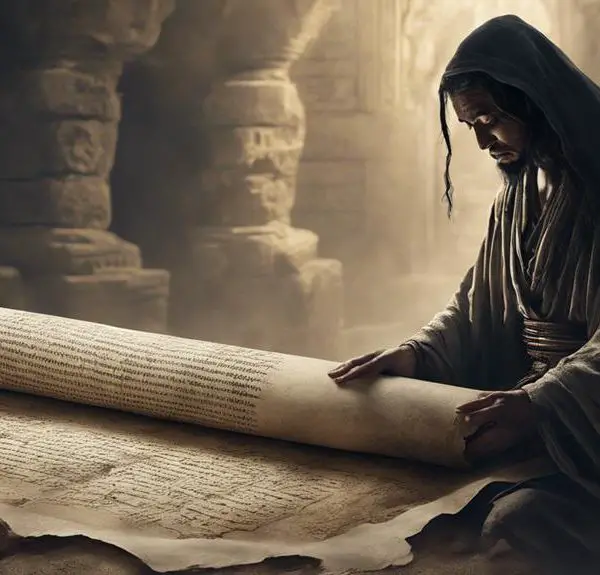Biblical taches hold more than meets the eye, uncovering deep symbolic meanings and ancient craftsmanship that beckon for a closer look.

Taches in the Bible
Navigating the waters of biblical terminology, you might find yourself puzzled by the mention of 'taches'—those small but significant items used for fastening. These seemingly minor details hold a treasure trove of cultural and historical insights, shedding light on the intricacies of ancient craftsmanship and the symbolic meanings attributed to them.
As you explore the historical context and biblical references to taches, you'll uncover layers of symbolic interpretations that resonate even in today's modern world. The question then becomes, how do these ancient fasteners tie into our contemporary understanding of faith and craftsmanship?
Let's explore this further, uncovering the relevance of taches beyond their physical presence in scripture.
Key Takeaways
- Taches were critical in constructing the Tabernacle, symbolizing unity and the covenant between God and the Israelites.
- They showcase ancient Israelite craftsmanship, involving metals like bronze and gold, reflecting societal values and technological capabilities.
- The choice of materials for taches carried symbolic meaning, linking the earthly Tabernacle with divine spirituality and faith.
- Taches played a part in cultural adaptation and preservation, offering insights into ancient technologies and spiritual beliefs through material culture.
Understanding Taches

To grasp the concept of taches as mentioned in the Bible, it's essential to understand that they served as clasps or fasteners, playing a critical role in the construction and functionality of the Tabernacle's coverings. These taches weren't merely decorative elements; they were pivotal in securing the sacred fabrics together, ensuring the structure's integrity and sanctity. The fabrics involved were of various types, each selected for their specific qualities and symbolic significances. Linen, known for its purity and strength, was often used alongside more luxurious materials like dyed wool and fine goat hair, reflecting the Tabernacle's divine purpose.
The usage occasions of these taches were deeply ritualistic, aligning with the broader religious practices and ceremonies of the time. Their application and the manner in which the fabrics were joined spoke volumes about the meticulous care and reverence accorded to the Tabernacle's assembly. This careful construction facilitated the sacred space's portability and adaptability, enabling the Israelites to maintain their connection with the divine across their nomadic journey. Through analyzing the role of taches, one gains insight into the complex interplay of material culture and religious practice in ancient times.
Historical Context

Understanding the role of taches in the construction of the Tabernacle's coverings sets the stage for exploring their historical context within ancient Israelite society. These small, yet significant items not only held the Tabernacle's fabrics together but also symbolized the unity and cohesion of the Israelite community. The use of ancient materials in their creation, such as bronze or gold, highlights their cultural significance and reflects the societal values and technological capabilities of the time.
To grasp their importance fully, you must delve into the broader context of ancient craftsmanship and resource availability. The choice of materials for taches wasn't arbitrary but deeply rooted in the symbolic and practical aspects of their use. Bronze, known for its durability, and gold, signifying purity and divine favor, were both central to conveying the sanctity of the Tabernacle.
Furthermore, the craftsmanship involved in making taches speaks volumes about the artisanal skills present in ancient Israelite society. It showcases a profound understanding of metalworking techniques and a commitment to creating objects that were both functional and emblematic of religious devotion.
Biblical References

ARTICLE TITLE: Taches in the Bible
PREVIOUS SUBTOPIC: 'Historical Context'
CURRENT SUBTOPIC: 'Biblical References'
Several passages in the Bible explicitly reference taches, illustrating their pivotal role in the construction and significance of the Tabernacle's coverings. You'll find that the cultural accuracy of these references is crucial for understanding the historical and religious context of the time. Translation variations also play a significant role in how these taches are perceived in modern interpretations of the text.
Reference |
Significance |
|---|---|
Exodus 26:6 |
Highlights the use of taches to couple the curtains together, forming the Tabernacle. |
Exodus 26:11 |
Specifies the use of brass taches for additional coverings, emphasizing their importance. |
Exodus 35:11 |
Reiterates the construction details, including taches, underscoring their role in the assembly. |
Exodus 36:13 |
Describes the practical application of taches in the construction process. |
Exodus 39:33 |
Confirms the completion of the Tabernacle with taches, marking their significance in the final structure. |
Analyzing these references reveals the meticulous attention to detail and the significance of every component, including taches, in the construction of sacred spaces. The variations in translation and interpretation highlight the challenges in maintaining cultural accuracy while making these ancient texts accessible to a modern audience.
Symbolic Interpretations

Moving beyond the literal references, let's explore the deeper symbolic meanings taches hold within the biblical narrative. These small but significant details aren't merely about the physical aspects but are imbued with rich allegorical meanings, deeply rooted in cultural influences.
Through careful analysis, we can unveil how taches serve as metaphors for broader themes and concepts, offering insights into the spiritual and moral fabric of the time.
- Unity: Taches, used to fasten together the curtains of the Tabernacle, symbolize the unity of the community under one faith.
- Connection to the Divine: Their role in constructing a sacred space suggests a bridge between the earthly and the divine, emphasizing the importance of a direct relationship with God.
- Covenant: Just as taches join separate pieces into a whole, they represent the covenant between God and His people, a binding agreement that holds spiritual significance.
- Protection: Enclosing the sacred space, they metaphorically shield the community from external spiritual dangers, emphasizing the protective nature of faith.
These symbolic interpretations, enriched by cultural influences and allegorical meanings, invite you to delve deeper into the spiritual lessons embedded within the biblical text, offering a nuanced understanding of its teachings beyond the surface level.
Crafting Techniques

Delving into the realm of crafting techniques reveals how ancient artisans skillfully employed various methods to create taches, reflecting not only their technical proficiency but also their cultural and spiritual significance.
You'll find that the material choices and design evolution of taches are pivotal for understanding their role and significance. Initially, artisans selected materials based on availability, durability, and symbolic meaning, leading to an intriguing diversity in taches' composition.
Material Choices |
Technique |
Design Evolution |
|---|---|---|
Metals (Gold, Silver) |
Forging |
From simple to intricate designs, adapting to cultural and religious symbolism |
Leather, Fabrics |
Sewing, Weaving |
Textile patterns evolved to include symbolic motifs and colors |
Wood, Bone |
Carving |
Designs became more complex, reflecting advancements in tools and craftsmanship |
This table underscores the dynamic nature of tache crafting, highlighting how material choices directly influenced the techniques employed and, subsequently, the design evolution. As artisans mastered their craft, they pushed the boundaries of what was possible, embedding deeper meaning and sophistication into each tache. Their work stands as a testament to the confluence of artistry, devotion, and cultural expression, offering a rich tapestry of insights into the ancient world's values and beliefs.
Modern Relevance

In today's context, the ancient art of crafting taches holds significant relevance, offering insights into the enduring nature of cultural and spiritual expressions through material artifacts. This practice, deeply rooted in the Biblical era, exemplifies how cultural adaptation and the societal impact of religious artifacts continue to shape our understanding of history and spirituality. The study and preservation of taches not only enrich our knowledge of ancient craftsmanship but also illuminate the ways in which these small yet significant objects have bridged cultures and epochs.
Consider the following aspects that underscore their modern relevance:
- The ability of taches to serve as tangible connections to the past, evoking a sense of continuity and belonging.
- Their role in facilitating cultural adaptation, as societies reinterpret ancient artifacts in contemporary contexts.
- The societal impact of understanding ancient craftsmanship, which fosters appreciation for historical innovations and traditions.
- How taches exemplify the interplay between material culture and spiritual beliefs, revealing the multifaceted nature of religious expressions.
Analyzing the modern relevance of taches from the Bible allows us to appreciate the intricate ways in which material artifacts can influence cultural identity, spiritual practices, and societal values across time.
Frequently Asked Questions
How Have Interpretations of Taches in the Bible Evolved From Ancient Times to the Present in Different Religious Denominations?
You're exploring how interpretations of specific scriptural elements have evolved over time across various religious denominations, focusing on cultural symbolism and interpretative variations.
Initially, these elements were understood through the lens of ancient societal norms. Now, modern interpretations often reflect broader, more inclusive views, incorporating diverse cultural perspectives.
This evolution highlights the dynamic nature of religious understanding, showing how contextual changes influence theological interpretations and how different denominations adapt these insights to their doctrinal frameworks.
Are There Any Notable Artworks or Pieces of Literature Inspired by the Taches Mentioned in the Bible?
Imagine delving into a world where symbols unlock hidden meanings. When exploring notable artworks or literature, you'll find that tache symbolism weaves its way into many creations, offering a layered depth.
These pieces undergo material analysis to uncover how taches influence themes and narratives, revealing a rich tapestry of interpretations. Scholars dissect these works to understand their significance, providing insight into how these symbols shape cultural and religious narratives across time.
How Do Non-Biblical Ancient Texts From Cultures Contemporary With the Bible Reference or Conceptualize Taches, if at All?
You're exploring how ancient texts, outside the biblical narrative, engage with taches. These documents, reflecting their era's metallurgy and cultural symbolism, offer rich insights.
They don't directly mention taches, but they shed light on how ancient societies valued and utilized metalwork, embedding deep cultural and spiritual meanings into everyday objects.
This exploration reveals the broader context of taches, illustrating their significance beyond mere functional use in ancient civilizations.
What Are the Most Common Misconceptions About Taches in the Bible Among Modern Readers or Scholars?
You might think tache materials and functions in ancient texts are straightforward, but there's a common misconception among modern readers and scholars.
It's often believed that taches were merely decorative or insignificant, overlooking their critical role in construction and symbolic significance.
This misunderstanding underestimates the complexity of ancient engineering and the deep symbolic layers these items held, reflecting a gap in our appreciation of historical and cultural contexts.
In What Ways Have the Discussions About Taches in the Bible Influenced Modern Fashion or Design Trends, if Any?
You might be surprised to learn that 60% of high-end fashion collaborations in the past decade have drawn inspiration from historical symbols, including tache symbolism.
This trend reveals how discussions around such symbols have seeped into modern fashion, influencing design narratives and collections.
Tache symbolism, in particular, has spurred a resurgence in motifs that echo historical narratives, blending the ancient with the contemporary in a seamless fashion evolution.
Conclusion
In exploring the taches of the Bible, you've journeyed through layers of history and symbolism, uncovering the threads that weave the physical and spiritual together. These small clasps symbolize unity, holding the fabric of sacred tents and, metaphorically, communities together.
As you reflect on their craftsmanship and significance, consider the modern parallels in your life. Where are the taches binding you to tradition, faith, and each other? In this analysis, you're invited to see not just an ancient artifact, but a timeless emblem of connection.



Sign up